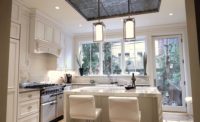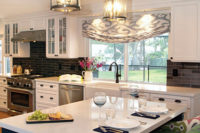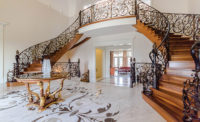Natural stone has always been a popular choice when designing a kitchen or bathroom, but lately, another material with similar technical characteristics has become a viable option on today’s market. With the durability and refined look of natural stone, engineered quartz has emerged as one of the new “go-to” choices for countertops and tub surrounds alike.
The crystal-like material, which has stain- and scratch-resistant qualities, a flexible nature and uniform color, has recently become a major competitor of natural stones. “Every quartz manufacturer is trying to match Calacatta marble,” said Buddy Ontra, owner of Ontra Stone Concepts in Bridgeport, CT. “Some are better than others. Some have several Calacatta types to choose from.
“The Calacatta, Carrara and cement-style colors seem to be more prevalent with the end users,” Ontra went on to explain. “In second place is limestone, particularly the Crema Marfil and Botticino look-a-likes. The homeowner wants a natural look with manmade durability.”
Joe Dwyer, president of Dwyer Marble & Stone in Farmington Hills, MI, agreed with Ontra. “The most desired look in quartz today is inspired by the classic white marbles of Carrara, Italy, which Aurea Stone has been able to successfully capture in their collection of the most coveted white marbles,” he said. “We are definitely seeing other surfaces inspiring quartz designs such as slate- and concrete-textured materials. Santa Margherita’s Wave and Metropolis series of materials have a process which does replicate the texture, look and undulations of natural slate and concrete extremely well.”
Aside from countertops and vanities, designers are also pushing boundaries with quartz applications nowadays, according to Lorenzo Marquez, vice president of marketing for North America at Cosentino. “Designers and homeowners are beginning to get creative with applications, using quartz for backsplashes, shower wall cladding and tub surrounds,” he said. “Livability is having a greater and greater influence on what homeowners and designers select in their spaces — for countertops and beyond. Quartz offers a durable surface that captures most design aesthetics without the risk of staining.”
Marquez agreed that most inspiration for quartz colors is drawn from the aesthetics of natural stones, but also mentioned how he’s observing inspiration from other natural materials. “A lot of Silestone’s colors are inspired by natural stone,” he explained. “The success of Silestone’s Nebula, Nebula Code and Nebula Alpha Series are strong indicators that there is, indeed, a demand for quartz surfacing inspired by marble or natural stone looks. As preferences from designers and homeowners continue to evolve, we also continue our commitment to innovation, introducing more colors with veining and movement, like Silestone’s three recently launched new colors — Kimbler Mist, Royal Reef and Pietra — inspired by exotic natural stones such as granite, limestone and marble.
“Silestone has also branched out to provide completely different offerings like Etchings from the Influencer Series, which is a modern take on terrazzo,” Marquez added. “Dekton by Cosentino, an ultracompact surface material manufactured from quartz, porcelain and glass, is a line of material that provides the look of wood, concrete and steel with even greater technical benefits.”
While stone-inspired looks are proving successful, both Ontra and Marquez are observing one color in particular that continuously attracts customers. “Homeowners have embraced whites — whether off-white, beige or arctic whites — for countertops, backsplashes and vanities,” said Marquez. “These colorways will always be a popular surfacing option.”
Dwyer, who thrives off of constant feed from K&B showrooms and fabricators, added how shades of grays are currently trending as well. “The Four Elements Quartz Surfaces (4E)developed a color for us after receiving direct feedback,” he explained. “’Alaska,’ inspired by a natural granite called ‘Bianco Alaska,’ had been a very successful color.”
The future of quartz
As some stones require maintenance and have risks of staining and scratching, quartz has become a perfect replacement for high traffic applications. To stay ahead of the curve, companies have adapted products to meet consumers’ needs. “Cosentino keeps a constant pulse on market demands and integrates feedback from industry professionals into new color development,” said Marquez. “Cosentino has developed granite and marble looks to meet these consumer needs and is currently working on several new Silestone colors inspired by ever-popular and coveted Calacatta marble so homeowners can get the look, without the maintenance.”
While Ontra sees new quartz manufacturers all the time, he cannot predict what the future holds for those companies or their success, but makes sure to relay all of his knowledge about the product to his customers. “As quartz grows in popularity and I learn more about its strengths and shortcomings, I try to pass that on to the end users, as the marketing for this is huge,” he said. “Not speaking for all, but many sales representatives haven’t worked with it, haven’t broken it, haven’t scratched and repaired it, and haven’t inhaled the dust — so I help to provide
that insight.”
Since the material keeps expanding, with more options being offered, Dwyer encourages people to “look beyond the usual suspects” and keep an open mind. “There are some phenomenal new manufacturers on the scene, such as Aurea Stone and Four Elements Quartz Surfaces,” he said.
“Recently, quartz has evolved the most from an aesthetics and installation standpoint,” added Marquez. “Now, Cosentino is developing colors with more depth, movement, shine and technical properties — allowing designers to incorporate a greater variety into their surfacing choices. The performance, functionality, maintenance and price point are all solid reasons as to why quartz is a leading surfacing product. Quartz is here to stay and manufacturers will continue to develop new colors that keep the product at a competitive price point from its natural stone counterparts.”







